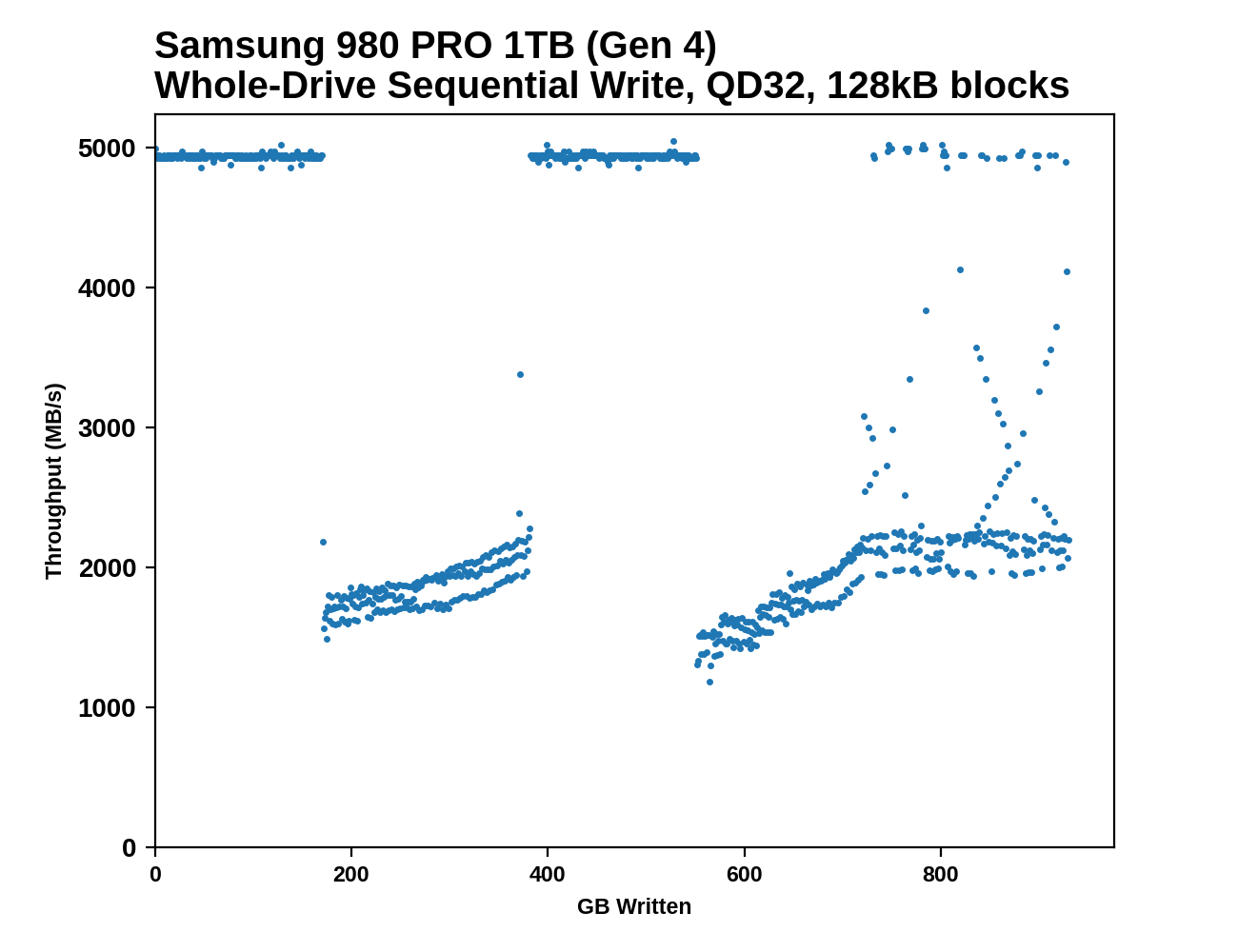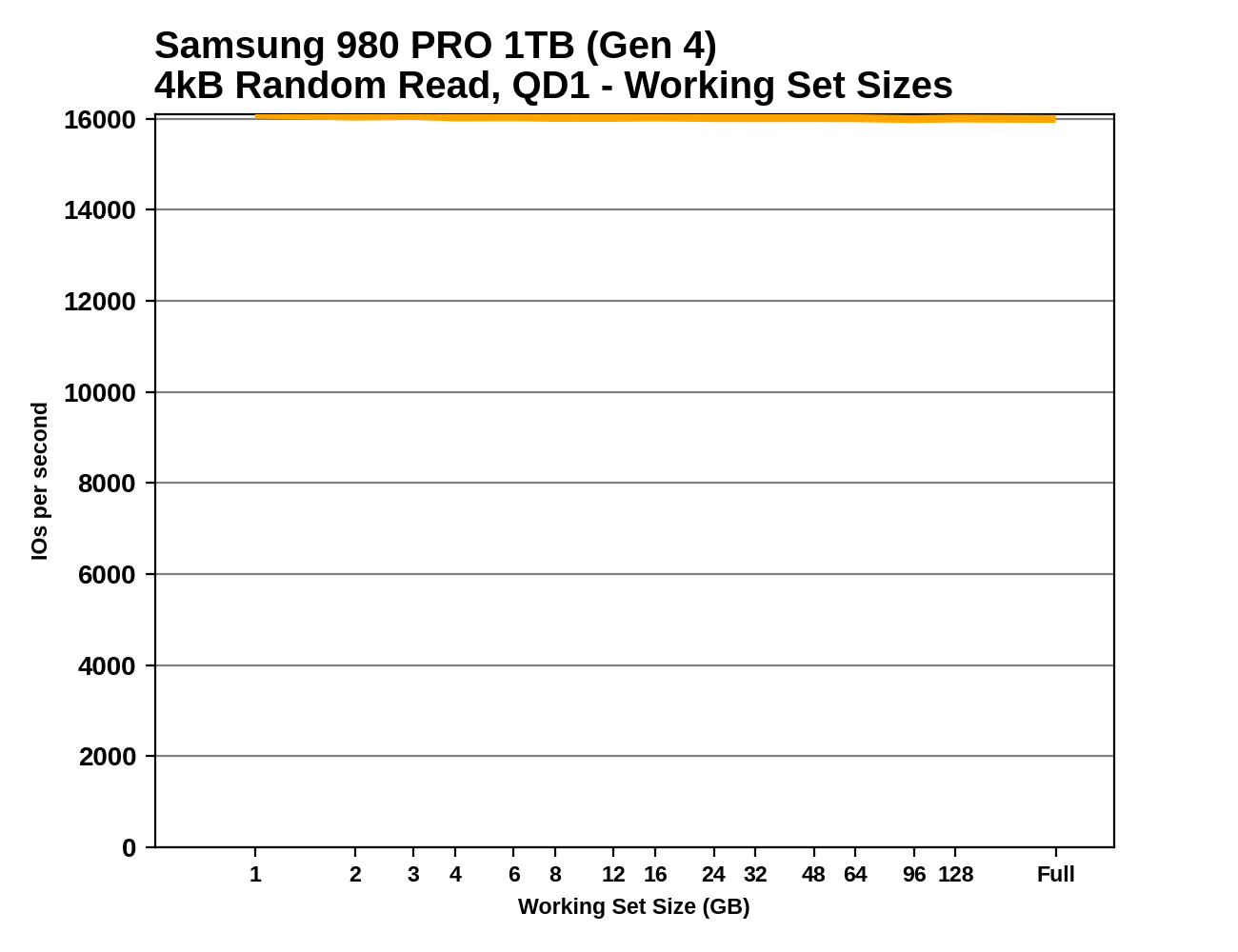The Samsung 980 PRO PCIe 4.0 SSD Review: A Spirit of Hope
by Billy Tallis on September 22, 2020 11:20 AM ESTWhole-Drive Fill
This test starts with a freshly-erased drive and fills it with 128kB sequential writes at queue depth 32, recording the write speed for each 1GB segment. This test is not representative of any ordinary client/consumer usage pattern, but it does allow us to observe transitions in the drive's behavior as it fills up. This can allow us to estimate the size of any SLC write cache, and get a sense for how much performance remains on the rare occasions where real-world usage keeps writing data after filling the cache.
 |
|||||||||
Both tested capacities of the 980 PRO perform more or less as advertised at the start of the test: 5GB/s writing to the SLC cache on the 1TB model and 2.6GB/s writing to the cache on the 250GB model - the 1 TB model only hits 3.3 GB/s when in PCIe 3.0 mode. Surprisingly, the apparent size of the SLC caches is larger than advertised, and larger when testing on PCIe 4 than on PCIe 3: the 1TB model's cache (rated for 114GB) lasts about 170GB @ Gen4 speeeds and about 128GB @ Gen3 speeds, and the 250GB model's cache (rated for 49GB) lasts for about 60GB on Gen4 and about 49GB on Gen3. If anything it seems that these SLC cache areas are quoted more for PCIe 3.0 than PCIe 4.0 - under PCIe 4.0 however, there might be a chance to free up some of the SLC as the drive writes to other SLC, hence the increase.
An extra twist for the 1TB model is that partway through the drive fill process, performance returns to SLC speeds and stays there just as long as it did initially: another 170GB written at 5GB/s (124GB written at 3.3GB/s on Gen3). Looking back at the 970 EVO Plus and 970 EVO we can see similar behavior, but it's impressive Samsung was able to continue this with the 980 PRO while providing much larger SLC caches—in total, over a third of the drive fill process ran at the 5GB/s SLC speed, and performance in the TLC writing phases was still good in spite of the background work to flush the SLC cache.
 |
|||||||||
| Average Throughput for last 16 GB | Overall Average Throughput | ||||||||
On the Gen4 testbed, the overall average throughput of filling the 1TB 980 PRO is only slightly slower than filling the MLC-based 970 PRO, and far faster than the other 1TB TLC drives. Even when limited by PCIe Gen3, the 980 Pro's throughput remains in the lead. The smaller 250GB model doesn't make good use of PCIe Gen4 bandwidth during this sequential write test, but it is a clear improvement over the same capacity of the 970 EVO Plus.
Working Set Size
Most mainstream SSDs have enough DRAM to store the entire mapping table that translates logical block addresses into physical flash memory addresses. DRAMless drives only have small buffers to cache a portion of this mapping information. Some NVMe SSDs support the Host Memory Buffer feature and can borrow a piece of the host system's DRAM for this cache rather needing lots of on-controller memory.
When accessing a logical block whose mapping is not cached, the drive needs to read the mapping from the full table stored on the flash memory before it can read the user data stored at that logical block. This adds extra latency to read operations and in the worst case may double random read latency.
We can see the effects of the size of any mapping buffer by performing random reads from different sized portions of the drive. When performing random reads from a small slice of the drive, we expect the mappings to all fit in the cache, and when performing random reads from the entire drive, we expect mostly cache misses.
When performing this test on mainstream drives with a full-sized DRAM cache, we expect performance to be generally constant regardless of the working set size, or for performance to drop only slightly as the working set size increases.
 |
|||||||||
Since these are all high-end drives, we don't see any of the read performance drop-off we expect from SSDs with limited or no DRAM buffers. The two drives using Silicon Motion controllers show a little bit of variation depending on the working set size, but ultimately are just as fast when performing random reads across the whole drive as they are reading from a narrow range. The read latency measured here for the 980 PRO is an improvement of about 15% over the 970 EVO Plus, but is not as fast as the MLC-based 970 PRO.










137 Comments
View All Comments
Slash3 - Wednesday, September 23, 2020 - link
Yeah, we may get a few early test case scenarios through an Nvidia demonstration or partner product, but any major release will probably wait to land concurrently with a full fat Directstorage update from Microsoft. I'm looking forward to it, as I've got a pretty fast storage subsystem and very few games take advantage of it even during asset loading.vanish1 - Tuesday, September 22, 2020 - link
no headphone jack, no purchase.racerx_is_alive - Tuesday, September 22, 2020 - link
Do we know enough about the new DirectStorage API to make a prediction about how this will perform against the 4.0 Phison controller next year? Seems like that will be a real world situation that will use lots more queues and shift performance towards the Samsung.KenK74 - Tuesday, September 22, 2020 - link
This product release is a real yawner. I am keeping my 970 Pro's, and will be searching anywhere but Samsung for decent TLC's with Hardware Encryption capability when I need another. Depending on platform, software Bitlocker may not slow the drive down much, or might do so a lot. For laptops, the real problem is the extra CPU power for software encryption that exceeds differences in SSD power among the SSD drives. Yeah, hardware bitlocker has its issues, but it seems the most power efficient option for laptops that need bitlocker. Meanwhile for non-hardware encrypted drives, the SK Hynix P31 looks very good, runs with the PCI4 drives in many aspects,, and has a great price.PopinFRESH007 - Tuesday, September 22, 2020 - link
Which Phision controller are you referencing? They have multiple PCIe 4.0 controllers and most of them are already available. The E16T has been available in multiple products since early in the year and the E18 is the controller for the recently announced Sabrent Rocket 4 Plus which (on paper) looks to offer better performance than the 980 Pro. The Rocket 4 Plus looks like it should also be available this year and there are a couple of other drives that are expected to launch in Q4 that will also likely be using the E18dudlej84 - Tuesday, September 22, 2020 - link
I'm confused by the conclusion claiming it regains the performance crown, but the results seem to show it beaten quite often, even by the 970 pro and 970 evo plus in some cases. What am I missing?XabanakFanatik - Tuesday, September 22, 2020 - link
You're not missing anything, this is just corporate ass-wiping to reward Samsung for their terrible marketing decision to devalue the Pro brand they've been creating for a decade.StrangerGuy - Friday, September 25, 2020 - link
Besides their flagship phones, I can't think of any Samsung product that aren't terrible in terms of value for money in recent years.alexdi - Tuesday, September 22, 2020 - link
This is not a Pro drive. "Pro" means it maintains performance. This is a slightly faster Evo Plus and underwhelming for the price.PeachNCream - Tuesday, September 22, 2020 - link
That is some trash endurance for the price. The performance numbers are okay, but not the slightest bit earth shattering. I guess in the grand scheme of things, there appears to be no really good reason for this drive to even have gone into production for as little as it brings to the table. At least it isn't QLC, but it's pretty obvious that we have reached the end of NAND and need a more durable and higher density storage medium for the solid state side of the equation.